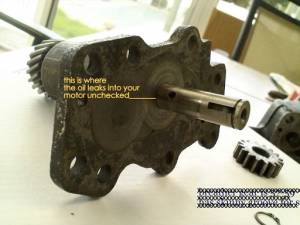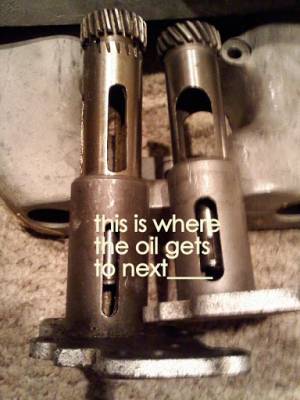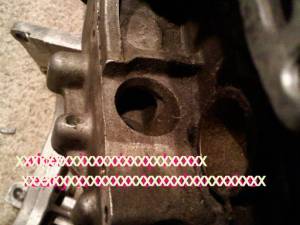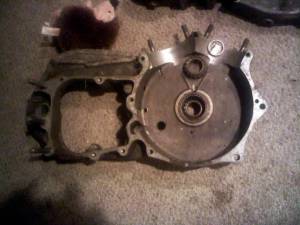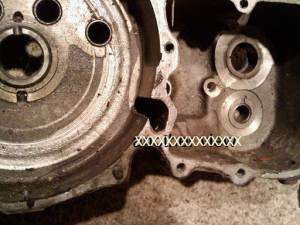IH: Oiling & Lubrication - Sub-01T
Further Study of the Transfer Valve Operation and Affects of Plugging the Valve
Plug the Transfer Valve or Not?
There are many debates over the actual function of the transfer valve as well as plugging it.
If you plug it, theoretically no more oil should enter the primary due to sit sumping. Read more on Sit Sumping in the Sportsterpedia.
Normally, if the bike does wet sump, excess oil will trickle into the primary case. 1)
When you start the engine, the return oil system will gradually empty the contents of the crank cases back to the tank.
It will also shoot excess oil out through the gear case breather onto your clean floor.
Once the excess oil is removed from the crank cases it will start drawing oil in through the transfer valve until the oil level is returned to it's correct level.
At that point, your oil tank should have returned to it's correct level and the engine should be running normally.
The transfer valve also allows oil to flow from the primary back into the crankcase if the sprocket shaft seal was leaking.
2)
Excess oil gets into the primary through a bad crank seal or poor sealing of the oil pump.
Keep in mind that drain oil from the top end also comes down the pushrod tubes and settles in the gearcase and down the holes in the cylinders into the crankcase.
Any oil that gets in the gearcase floods the oil pump scavenge inlet and runs back into the crankcase oil slot.
But, the oil was originally in the tank when the engine was shut off last.
It gets to the crankcase thru normal top end drainage, the check valve or oil seal issues in the oil pump, flooding the oil trap, then to the crankcase, up the wall and into the primary thru the transfer valve.
So plugging the transfer valve only addresses issues with oil getting into the primary from the crankcase but doesn't address excess oil getting into the crankcase.
These are separate and equally important issues.
Main reasons for plugging the transfer valve:
- To stop oil from filling the primary compartment when the engine sits for a while.
- To enable you to run separate oils in the primary and the engine without cross contamination. 3)
- To run the primary dry. People do that to run belts (even though it's not necessary). 4)
So there is technically no need to have the transfer function to remove sumped oil from the primary.
However, if the crank seal blows out, you'll end up with a primary full of oil and lower oil flow to the engine due to half of the oil being in the primary.
But that's a separate issue you'd have to fix with or without the transfer valve functioning.
Quote from thefrenchowl of the XLFORUM 5)
H-D called this an “oil transfer valve” from its 1st application on the K model where indeed it acted as a suck valve for excess oil in the tranny due to a poor oil seal design on the engine sprocket. It had a tube attached to it, bent down towards the bottom of the sprocket. When oil level was normal in the tranny, it just sucked air. When the oil level went up, it submerged the tube and the vacuum in the crank cases sucked out the excess in the crank cases. The bad sealing idea was discarded in '54 and replaced with a proper lip seal and our unloved transfer valve. The guy who designed it is an unsung genius, cause it's real purpose, intended or not, wasn't discovered until the factory got rid of it in the late 70s. That's when they noticed that bikes which did not see constant use got various amounts of rust building up in the tranny, despite it having the small hole breather in the filler alloy cap and a special vent bolt installed on top of the tranny. A new problem they never experienced in the past engines. They then discovered there was little air circulation despite the 2 vents in these trannies and moisture stayed in to do the damage. In earlier engines, air is constantly being replaced in the tranny by the one way valve/crankcase vacuum and moisture can escape. So, if you use your bike daily, by all means, discard (the transfer valve). Personnally, I think it's a great idea and never experienced its failure in all the years I've been riding Iron Sporties or Ks, nearly 30 years now. If a part is in there, it's got a purpose. I've had too much oil in the tranny as anybody has experienced, but it's always been a seal failure, nothing to do with the transfer valve.
…… The foregoing by Dr Dick 6)
The purpose of the transfer valve is to keep your garage floor clean.
It's an oil control device to control the oil in order to keep it in your bike.
There is so much speculation on this subject that sometimes the myth becomes the reality.
- The transfer valve is a part of a bigger system.
A system that we often break down into its components.
Then we deal with the (target component) often losing sight of the big picture.
It's our nature as mechanical guys.
Pin point the problem and then bring the hammers of Hell to bear on it.
If we can let go of that instinct for a moment this will make perfect sense.
So you want to think big picture here.
- The Transfer Valve:
- Fact: If you blow thru the valve it only allows flow from primary to engine.
- Fiction: That means its a one way check valve. Bad assumption.
It allows flow one way only when pressure is different one side of valve to other. See #3. - Fact: When taken apart carefully as not to bend the triangular reed we find no spring that 'checks' the valve when pressure differential is absent.
So it's allowed to 'leak' in state of equilibrium. - Fiction: There's something missing from this valve.
That's why its not checking and allowing leaking oil into my primary as I found when I left the primary cover off an saw the trail of oil from the valve.
If you dismiss the assumptions and stick with what we can prove this truth emerges:
The transfer valve is a one way feed when engine is running but not when engine is static.
(then it's relaxed and oil leaks from motor thru it) - Fact: Oil is leaking out of your valve when the primary cover is off.
(it's leaking when the primary cover is on too) - Fiction: There's only supposed to be a small amount of oil in the motor so there's something else wrong too. What could that be?
Aha, it's got to be the check valve in the oil pump leaking.
(This is the spot you go off course chasing ghosts. Because your motor is not running, oil is leaking into it before it even gets to the check valve).
- You are told to inspect the check valve in response to any noticeable change that increases oil exiting thru the breather tube.
Because a check that leaks will shorten the time it takes to fill the motor enough to puke. - Even a perfectly sealed check can't stop oil that's getting in thru a different path.
- If we slow down now and think, we get to this:
In order for the pump check to leak, oil has to get to the tank side of pump check.
In order to get there its got to sneak past gear clearance in pump (which it obviously does).
But this is not the only place this errant oil can go:
- So, oil is now filling the crankcase and not the cam chest.
The factory made sure that it happened like this.
They wanted this unchecked oil to stay out of the cam chest so that your bike is less likely to puke oil. - They didn't want the oil to just sit in the case sump either because it would just end up in the cam case soon after the bike was started.
- They wanted to somehow 'transfer' it to a reservoir allowing it to re-enter the engine in a controlled volume that the return pump could handle without being drowned.
- So oil flowing unchecked into the pump from the oil supply line leaks clear thru engine into primary before it can start to fill the cam chest.
On the primary side though, there is plenty of room to fill with the errant oil. - The transfer valve 'transfers' “pre pump check” oil leakage out of the motor and into the primary.
Where it re-enters the engine on startup in a controlled volume that the return pump could handle without being drowned. - In other words, it 'transfers' it back to engine when bike starts.
- This is the improvement refined from the 52-54 siphon tube that used the same valve guts.
- It does makes perfect sense don't it?
- Now, given some thought you will see why the valves aren't used on the racers.
- The '77 style oil system did away with the unchecked supply leakage. (so there is no reason to 'transfer' what isn't there).
- It's name is absolutely 100% correct: It's the transfer valve.
- The factory 'got it right' with this part.
- Keep an eye on the big picture.

